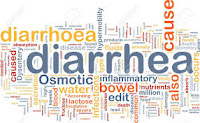Output is to increase the times of Defecation normal rates, and increasing the percentage of water outside of the body with the stool, so the texture is more liquid.
Diarrhea is pasty or liquid stools, the evacuations of which occur 3 or more times a day.
Acute diarrhea usually lasts a day or two.
From weeks onwards it is considered chronic, although symptoms can come and go.
It is not justified by states of anxiety, but is usually a sign of chronic illness.
The "nerves" do not cause diarrhea, only exceptionally and in very little quantity.
On the Bristol Stool Scale, numbers 5 to 7 are types of diarrhea.
Diarrhea causes low absorption of fluids and nutrients, and may be accompanied by abdominal pain, fever, nausea, vomiting, weakness, or decreased appetite.
In addition to the large loss of water from diarrhea, patients, usually children, lose dangerous amounts of important salts, electrolytes, and other nutrients.
Depending on the etiology, it may be accompanied by mucus, pus, or blood in the stool.
According to figures from the World Health Organization (WHO), diarrhea is one of the main causes of death in developing countries, deeply associated with dehydration.
Diarrhea can be infectious or non-infectious. Infectious disease is the main cause in environments with poor hygienic-sanitary conditions or a shortage of clean water for drinking, cooking and washing, as occurs in underdeveloped or developing countries.
It is caused by various bacteria, parasites, and viruses.
The most common causes of non-infectious diarrhea include celiac disease, non-celiac gluten sensitivity, food allergies, food intolerances (such as lactose or fructose intolerance), irritable bowel syndrome, inflammatory bowel disease, hyperthyroidism and the side effects of certain medications.
Celiac crisis, a possible presentation or withering complication of celiac disease, is commonly mistaken for infectious diarrhea.
Water and sanitation play a crucial role in the transmission of infectious diarrheal diseases.
These environmental factors contribute to approximately 94 percent of the 4 billion cases of diarrhea that WHO estimates occur annually in the world.
Children under the age of five in developing countries are the most affected, accounting for 90 percent of the 1.8 million deaths annually from diarrhea, mainly in underdeveloped countries.
In Latin America and the Caribbean, approximately 77,600 children under the age of five die each year from diarrhea and its consequences, which means more than 200 deaths daily.
While 16 of the 33 countries in that region are on track to achieve the UN Millennium Development Goals for sanitation and clean water, they still have to meet the sanitation needs of 8.4 million people, and in the case of drinking water of 6.1 million (September 2007, data from the Population Reference Bureau in the United States).
In veterinary medicine, all animals with acute diarrhea show common characteristics and require a similar clinical approach.
The diagnosis is established through medical history and clinical signs, and is subsequently confirmed by the results of stool evaluation, blood biochemistry, and blood count.
Diarrhea is pasty or liquid stools, the evacuations of which occur 3 or more times a day.
Acute diarrhea usually lasts a day or two.
From weeks onwards it is considered chronic, although symptoms can come and go.
It is not justified by states of anxiety, but is usually a sign of chronic illness.
The "nerves" do not cause diarrhea, only exceptionally and in very little quantity.
On the Bristol Stool Scale, numbers 5 to 7 are types of diarrhea.
Diarrhea causes low absorption of fluids and nutrients, and may be accompanied by abdominal pain, fever, nausea, vomiting, weakness, or decreased appetite.
In addition to the large loss of water from diarrhea, patients, usually children, lose dangerous amounts of important salts, electrolytes, and other nutrients.
Depending on the etiology, it may be accompanied by mucus, pus, or blood in the stool.
According to figures from the World Health Organization (WHO), diarrhea is one of the main causes of death in developing countries, deeply associated with dehydration.
Diarrhea can be infectious or non-infectious. Infectious disease is the main cause in environments with poor hygienic-sanitary conditions or a shortage of clean water for drinking, cooking and washing, as occurs in underdeveloped or developing countries.
It is caused by various bacteria, parasites, and viruses.
The most common causes of non-infectious diarrhea include celiac disease, non-celiac gluten sensitivity, food allergies, food intolerances (such as lactose or fructose intolerance), irritable bowel syndrome, inflammatory bowel disease, hyperthyroidism and the side effects of certain medications.
Celiac crisis, a possible presentation or withering complication of celiac disease, is commonly mistaken for infectious diarrhea.
Water and sanitation play a crucial role in the transmission of infectious diarrheal diseases.
These environmental factors contribute to approximately 94 percent of the 4 billion cases of diarrhea that WHO estimates occur annually in the world.
Children under the age of five in developing countries are the most affected, accounting for 90 percent of the 1.8 million deaths annually from diarrhea, mainly in underdeveloped countries.
In Latin America and the Caribbean, approximately 77,600 children under the age of five die each year from diarrhea and its consequences, which means more than 200 deaths daily.
While 16 of the 33 countries in that region are on track to achieve the UN Millennium Development Goals for sanitation and clean water, they still have to meet the sanitation needs of 8.4 million people, and in the case of drinking water of 6.1 million (September 2007, data from the Population Reference Bureau in the United States).
In veterinary medicine, all animals with acute diarrhea show common characteristics and require a similar clinical approach.
The diagnosis is established through medical history and clinical signs, and is subsequently confirmed by the results of stool evaluation, blood biochemistry, and blood count.










